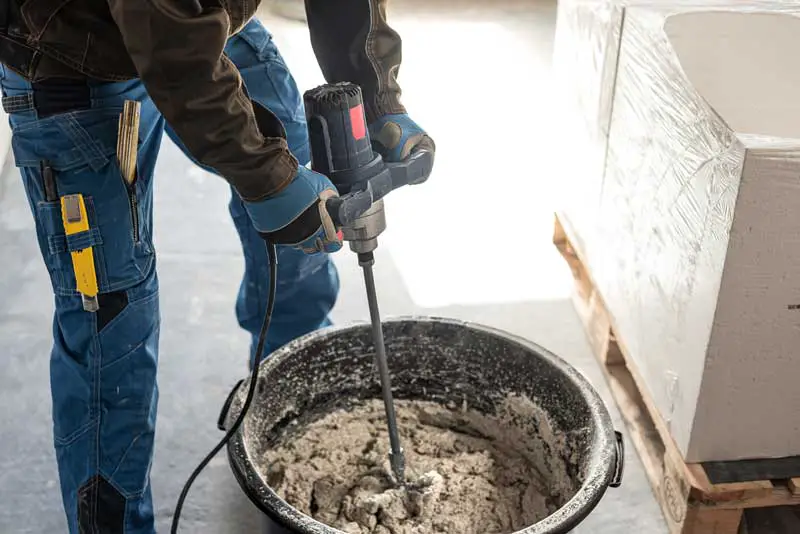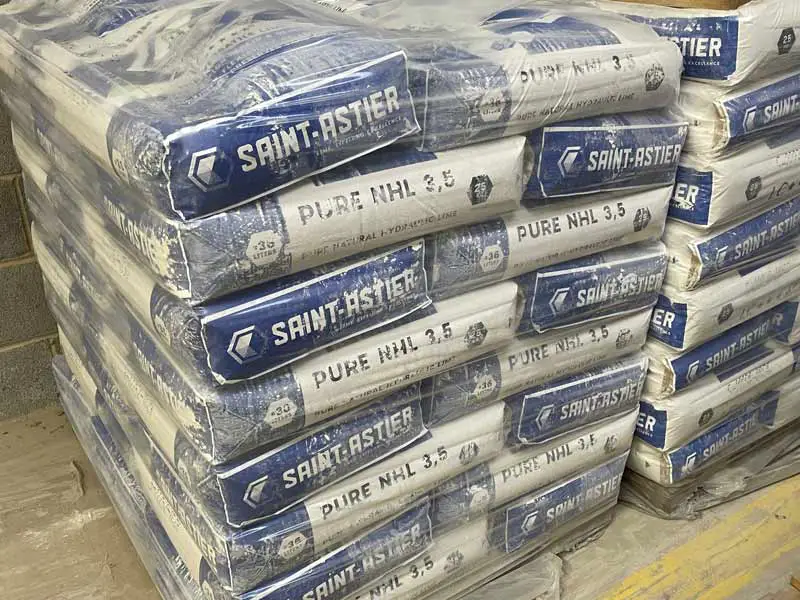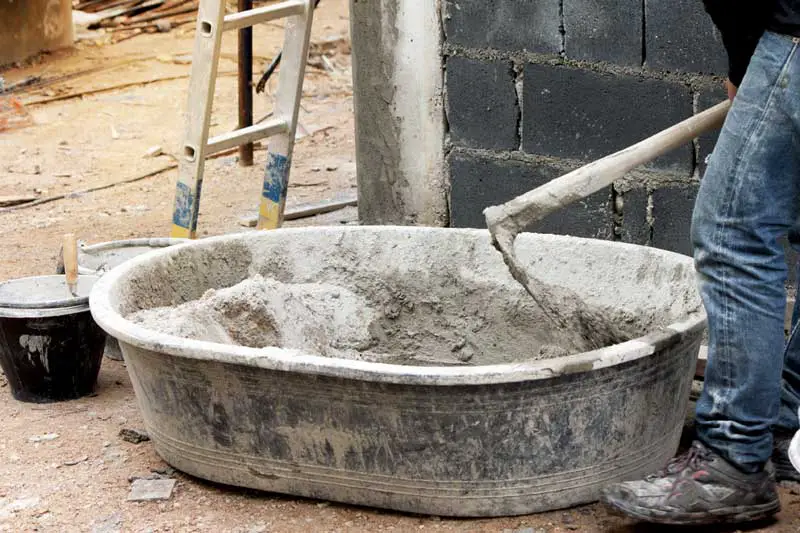
Lime mortar has been used for centuries in construction, and it remains a popular choice today for its durability, flexibility, and breathability. However, many people wonder whether they need to add water to lime mortars.
The type of lime you use for your project directly determines whether you should add water. Hydraulic limes, for example, are sold as a powder. This means you must add sand and water to make a workable lime mortar. Lime mortars should have the consistency of brown sugar.
In contrast, you can purchase pre-mixed non-hydraulic lime mortars. These are mortars made with fat lime and various sands and aggregates that are ready-mixed and usually sold in plastic bags. These types of lime mortars will usually not require any water to be added. It’s extremely easy to add too much water to pre-mixed mortars, so if you feel the mortar is too stiff, add very small amounts of water and mix well before adding more.
Now we have a basic overview of the general rules when adding water to lime mortars; let’s take a more detailed look.
What is Lime Mortar?
Lime mortar is a traditional building material that has been used for centuries. It is a mixture of lime, water, and an aggregate such as sand. Lime mortar is known for its durability and workability, making it a popular choice for construction projects.
Composition and Types of Lime Mortar
The composition of lime mortar varies depending on the specific type of lime used. There are two main types of lime: hydraulic and non-hydraulic.
Non-hydraulic lime is made from limestone that has been burned in a kiln. It is also known as air lime or quicklime. When mixed with water, it undergoes a chemical reaction called slaking, which produces calcium hydroxide. Non-hydraulic lime mortar hardens through a process called carbonation, where it absorbs carbon dioxide from the air and reverts back to limestone.
Hydraulic lime is made from limestone that contains impurities such as clay. When burned, these impurities create a hydraulic reaction that allows the lime to set underwater. Hydraulic lime mortar hardens through a combination of carbonation and hydraulic setting.
The aggregate used in lime mortar is typically sand, although other materials, such as crushed shells or volcanic ash, can be used. The ratio of lime to aggregate depends on the mortar’s specific application and desired properties.
Should Water be Added to Non-Hydraulic Lime Mortars?
When mixing non-hydraulic lime mortars, it is important to consider how much water should be added to the mix. Unlike hydraulic lime mortars, which require water for the chemical curing process, non-hydraulic lime mortars cure through a process called carbonation.

Carbonation occurs when the lime mortar is exposed to air which contains carbon dioxide, causing it to harden and set. Adding too much water to the mix can disrupt this process and weaken the overall strength of the mortar.
However, it is important to note that some water may be necessary to achieve the desired consistency and workability of the mortar. The amount of water needed will depend on several factors, including the type of sand used and the lime putty’s moisture content.
As a general rule, adding water in very small amounts is recommended, mixing the mortar thoroughly between each addition. It is also important to monitor the consistency of the mortar throughout the mixing process and make adjustments as needed. The final mortar should resemble the consistency of brown sugar.
In conclusion, the mortar must have enough water content to be soft, workable and usable. If too much water is added, the strength will be compromised, and you will encounter high shrinkage levels and cracking. If the water content is too low, the mortar will not be well combined and stuck together, leading to poor strength.
Related article: How To Stop Lime Mortar From Cracking
Should Water be Added to Hydraulic Lime Mortars?
When it comes to mixing hydraulic lime mortars, water is a crucial ingredient. However, it is important to add the right amount of water to achieve the desired consistency and strength of the mortar.
Adding too much water to the mix will result in a weaker and less durable mortar. On the other hand, too little water will prevent the chemical processes from taking place and weaken the material. It is essential to find the right balance between water and other ingredients to achieve the desired properties of the mortar.

When mixing hydraulic lime mortars, one general rule of thumb is to add water slowly until the desired consistency is reached. The mix should appear rather dry at first, but it will become more workable as water is added. It is important not to drown the mix by adding too much water, as this will weaken the final result.
It is also worth noting that the amount of water needed may vary depending on the type of sand used, the humidity, and the temperature of the environment. Therefore, it is important to monitor the consistency of the mix carefully and adjust the amount of water as necessary.
Overall, when mixing hydraulic lime mortars, it is important to add water carefully and in the right amount to achieve the desired consistency (that of brown sugar) and strength of the mortar. Finding the right balance between water and other ingredients can create a durable and long-lasting mortar that will stand the test of time.
Should Water be Added to Bought Pre-Mixed Lime Mortars?
What Are Pre-Mixed Lime Mortars?
Pre-mixed lime mortars are a convenient option for builders and DIY enthusiasts who want to use lime mortars without the hassle of measuring and mixing the ingredients themselves.
Pre-mixed lime mortars are typically sold in plastic bags and can be purchased at many specialist lime merchants and building supply outlets. They are made by mixing lime, sand, and other ingredients together in the correct proportions and bagging them up while wet.
Pre-mixed lime mortars can be stored wet in their plastic bags almost indefinitely. Non-hydraulic lime will only cure in the presence of carbon dioxide (CO2) in the air. So as long as the bags remain airtight, the pre-mixed mortars will remain in good condition.
Does Water Need to be Added to Pre-Mixed Lime Mortars?
Generally, water should not be added to pre-mixed lime mortars. When they are produced, they will have been made with the correct amounts of lime, aggregate and water. Over time, some pre-mixed lime mortars may stiffen in the bags or even appear rock hard.
As long as the bag is still sealed, even the stiffest lime mortars will return to their soft and malleable state once they have been thoroughly beaten and mixed.

It can be tempting to add water too early when ‘knocking up’ pre-mixed mortars. Usually, the more they are mixed, the softer they will become. Giving stiffer mortars a 10-minute mix would be best before adding water. You can do this using a paddle mixer, a mixing attachment for a drill or by hand. Cement mixers can be used but aren’t as effective as the other methods for lime mortars.
If you have been mixing a pre-mixed mortar for 10 minutes and decide it is still too stiff, you may add a very small amount of water and mix thoroughly again before adding more. Adding too much water to pre-mixed mortars can be easy, so please take great care.
Do You Need to Add Water to Lime Mortars?
Factors to Consider When Adding Water to Lime Mortars
The main factor to consider is the type of lime you are using. Hydraulic limes are sold as a powder and will therefore require water to be added to make a mortar and be able to set properly. Non-hydraulic limes, on the other hand, are usually sold as fat lime (which is a wet creamy substance) or pre-mixed lime mortars. Both of these limes will rarely require water to be added.
The temperature and humidity of the environment can also affect the amount of water needed. More water may be needed in hot and dry conditions to prevent the mortar from drying out too quickly. In cold and wet conditions, less water may be needed to prevent the mortar from becoming too runny.
How to Add Water to Lime Mortars
When adding water to lime mortars, it is important to do so gradually. Add water in small amounts (smaller than you think) and mix well before adding more. Adding more water is easy, but it can be a pain if too much is added and you have to wait for it to dry out.
It is also important to use clean water when mixing lime mortars. Contaminated water can affect the setting and strength of the mortar. A good rule of thumb is to use clean water suitable for drinking.
Overall, adding water to lime mortars is necessary, but the amount needed can vary depending on several factors. Considering these factors and adding water gradually makes it possible to achieve the proper consistency for the mortar.
Conclusion
Adding water to lime mortars is necessary to achieve the desired consistency for the specific application. However, gradually adding water and mixing the mortar thoroughly is important to avoid over-wetting. Overwetting can cause shrinkage and cracking as the mortar dries, compromising the structural integrity of the masonry.
Related article: Why Does Lime Mortar Fail? The Common Causes and Prevention
It is also important to use the correct ratio of sand to lime and choose the appropriate lime type for the specific application. The ratio of sand to lime can vary depending on the desired qualities of the mortar, such as strength, workability, and durability. The type of lime used can also affect the properties of the mortar, such as setting time and water resistance.
Overall, adding water to lime mortars is a necessary step in the mixing process. Still, it should be done carefully and in moderation to avoid compromising the quality of the final product. By following the guidelines and tips provided in this article, builders and masons can achieve the desired results and ensure the longevity and durability of the masonry construction.

